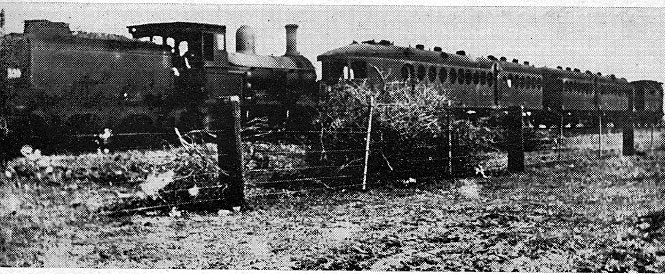The Railways of Altona
Three years after the first steam train in Australia ran from Melbourne to Sandridge (Port Melbourne) in 1854, a railway, the first Victorian country line was built between Geelong and Greenwich (This was in Newport but further south-east of the current Newport station) by the Geelong and Melbourne Railway Co. It is stated that the line was completed on 8 August 1857, the last rail being fastened near the present Laverton station. As the line lost money the Victorian Railways took the rail line in 1860.
The next railway in our area – “the shortest railway line in the Colony, it may be in the world” – served the Williamstown Racecourse. It branched off the Geelong line and ran to near Kororoit Creek just south of Kororoit Creek Road. It was opened on 6 April 1885.
The line to Altona proper was constructed privately by the Altona Bay Co. in 1888, and the first official trains ran to the Land Sale on 8th September the same year and on succeeding weekends. A twice daily six days a week service was provided by the company by means of a steam rail car which connected with a Government train at the racecourse that ran to Spencer Street. The service was cancelled 14 August 1890.
Initially there was one station only, “Altona” at Pier Street. Then in November 1888 the line was extended about a mile west to a station “Altona Beach” just east of Grieve Parade.
1890 – Passenger services ceased on 14 Aug 1890 due to poor property sales. A station called Hatherley near to where the Altona line branches off (3.2 km from Newport and 0.4 km from the later Paisley station) was built in 1890. It opened on 14 Feb 1890 but closed seven years later on 30 Jun 1897.
When Hosie opened his mine just past the “Altona Beach” platform in 1895 the Company hired a hired a steam engine from the Railways to work their railway between July 1895 and March 1896, possibly to haul coal. When this venture failed the railway fell into disuse until about 1908 when the Melbourne & Altona Colliery commenced operations. A spur was built from the old line beyond Altona station to the mine in 1909 and trains ran as required from Newport to bring in supplies and take out coal. In 1916 trains were used to bring in Army personnel to the camp at Altona.
1906 – Victorian Railways reached an agreement with the then owner of the line, Mr William H Croker, to stable trains on the line during Williamstown race meetings.
1909 – A loop siding existed beside the Altona platform for a number of years, and in 1909, a siding was extended west towards the site of Westona station, serving the Altona Coal Mine (now Harrington Square), which was operated by the Melbourne and Altona Colliery Company. Trains ran as required from Newport to bring in supplies and take out coal.
1916 – Trains were used to bring in Army personnel to the camp at Altona.
On 1 December, 1917, a steam passenger service was restored to the former “Altona” station at Pier Street, and the station renamed “Altona Beach”. The Land Co. paid for the train and the Railways ran it. Most of the engines and carriages used were of ancient vintage, but the two McKeen carriages (old petrol rail motors) with their motors removed, gave the line an individuality all its own.
 Image above: Altona Steam Train with McKeen Cars and Guard’s Van, about 1925.
Image above: Altona Steam Train with McKeen Cars and Guard’s Van, about 1925.
Initially in 1917 there were 10 return trips per day, but no service after 7p.m. Today there are 33.
Seaholme Station was constructed in 1920, the name being a winning entry in a competition held by the Land Company. Galvin station opened in 1927 near the level crossing on the Geelong-Newport line at Maidstone Street. Paisley stationed opened on the Geelong-Newport line near the Millers Road level crossing.
After protracted negotiations the line was taken over by the Victorian Railways on 1 December 1924, and electrified on 2 October 1926, the ribbon being cut by Mrs. Murphy, wife of the President of the Progress Association.
1938 – Altona Beach station was renamed to its former name “Altona”.
1950 – The Williamstown Racecourse was closed after World War II but it was not until 22 May 1950 that Williamstown Racecourse station ceased operating with its overhead equipment and sidings removed.
Mobiltown was added in 1953 to serve the oil refinery. It was originally called ‘Standard Oil Platform’ but was renamed in June 1954. It was made a public platform on 7 Sep 1958 with most trains timetabled to stop there.
With the duplication of the Geelong Line, Galvin station was rebuilt in 1965 as an island platform located between 2 tracks, southwest of the Maidstone Street level crossing.
1985 A new station named Westona was opened on 21 Jan 1985 and was then extended then to Laverton on 11 April 1985. Westona was also named from a winning entry in a naming competition. Westona was opened by then Minister for Transport Steve Crabb. The extension was 4.4 km long and provision was made for future duplication, however five roads were closed and two new level crossings were constructed at Maidstone Street and Grieve Parade.
The under-patronized Mobiltown, Paisley and Galvin stations were closed.
Mobiltown station was closed on 18 Jan 1985 and its platform was removed with no remains visible today. Australian singer-songwriter, Broderick Smith sang about the “Last Train From Mobiltown” on his group’s 1981 album Broderick Smith’s Big Combo. Both Paisley and Galvin stations were closed on 14 Apr 1985.
